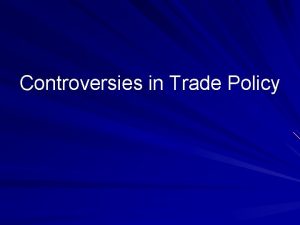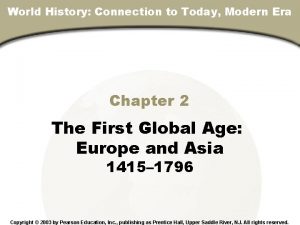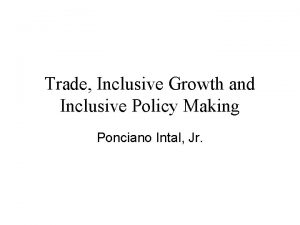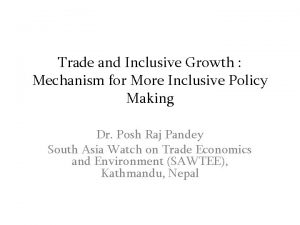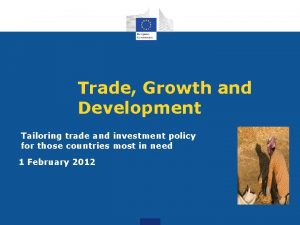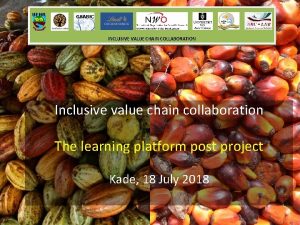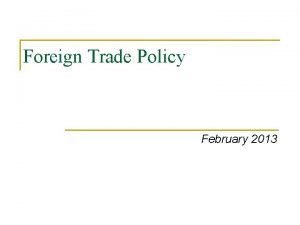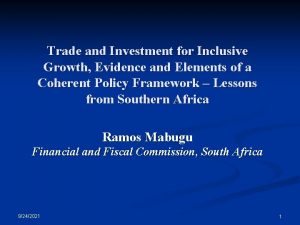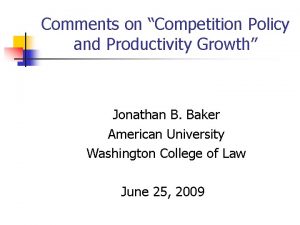Comments on Trade Inclusive Growth and Inclusive Policy


















- Slides: 18

Comments on Trade, Inclusive Growth and Inclusive Policy Making by P. S. Intal, Jr. Josef T. Yap Philippine Institute for Development Studies (PIDS) 9 December 2008

Record of Trade Liberalization

Development Has Lagged

Poverty Record is Disappointing Poverty and Inequality in East Asia Population in Proportion of Poverty Population (in percent) Below $1 (PPP) a Day 2002 -07 (%) 2002 -06 Gini Coefficient China 2. 50 10. 80 0. 47 Indonesia 16. 70 7. 70 0. 34 Malaysia 5. 10 0. 00 0. 40 Philippines 30. 00 13. 20 0. 44 Thailand 9. 80 0. 00 0. 42 Viet Nam 19. 50 8. 40 0. 37 Source: Asian Development Bank Key Indicators, 2007

Why Has Trade Liberalization Failed in Many Aspects? • EXCHANGE RATE POLICY NOT SUPPORTIVE • Rodrik, D. (2008): “The Real Exchange Rate and Economic Growth”. Downloaded from http: //ksghome. harvard. edu/~drodrik/R ER%20 and%20 growth. pdf (October).

Why Has Trade Liberalization Failed in Many Aspects? • Lack of a Strategic and Coherent Industrial Policy • Memiş, E. and M. F. Montes (2008): “Who’s Afraid of Industrial Policy? ” Discussion Paper, Asia Pacific Trade and Investment Initiative, UNDP Regional Centre in Colombo (May).

Why Has Trade Liberalization Failed in Many Aspects? • Poor physical infrastructure Ø Roots in the country’s external debt policy and weak tax effort • Weak institutions and poor governance

Why Has Trade Liberalization Not Been Inclusive? • Spotty record in improving human capital • Lack of Safety Nets • Labor market institutions, industrial relations

WHAT CAN BE DONE?

Main recommendation: Inclusive Policy Making • “An approach to ensuring that policies and strategies take into clear consideration the impact of such policies on disadvantaged groups, operationalize social integration of previously marginalized groups, and to enhance citizen participation in governance” • Q: Isn’t this DEMOCRACY?

Main recommendation: Inclusive Policy Making • Q: Why haven’t democratic institutions worked in the Philippines? • Q: Why are institutions weak? • Q: How does one strengthen institutions?

INDUSTRIAL POLICY • Review our tariff rates vis-à-vis WTO bound rates • Mining-Manufacturing Link • Competitiveness of Firms

ASEAN’s COMPETITIVENESS GOAL • Transform their economies from mass production-based ones relying on unskilled or semiskilled labor to knowledge-based ones. Knowledgebased economic activities comprise R&D, product and service design, high value-added skills processing and marketing for the domestic, regional and global market places (Ariff 2003 as cited by Yamazawa and Hiratsuka, 2003)

Strategic Industrial Policy: Main Areas • Human Resource Development • Technological Capability and Skill Development • Physical Infrastructure

Enhancing Technological Capability through Regional Cooperation and Integration • Fostering local firms/entrepreneurs: e. g. Local Industries Upgrading Program; New age economic agreements, e. g. JPEPA • Focus on SMEs

Main Elements of Fragmentation and Agglomeration

Main Elements of Fragmentation and Agglomeration § Emphasis should be at the subnational level § Involve local governments § Islands of excellence should lead the way

 Inclusive education policy
Inclusive education policy Trade diversion and trade creation
Trade diversion and trade creation Umich
Umich Which is the most enduring free trade area in the world?
Which is the most enduring free trade area in the world? Trade diversion and trade creation
Trade diversion and trade creation Tramp shipping and liner shipping
Tramp shipping and liner shipping Plant growth analysis
Plant growth analysis Ground tissue
Ground tissue Primary growth and secondary growth in plants
Primary growth and secondary growth in plants Vascular ray
Vascular ray The trade in the trade-to-gdp ratio
The trade in the trade-to-gdp ratio Fair trade not free trade
Fair trade not free trade Ted talk atlantic slave trade
Ted talk atlantic slave trade Activist trade policy
Activist trade policy Chapter 14 section 1 the search for spices
Chapter 14 section 1 the search for spices Step growth polymerization vs chain growth
Step growth polymerization vs chain growth Geometric vs exponential growth
Geometric vs exponential growth Neoclassical growth theory vs. endogenous growth theory
Neoclassical growth theory vs. endogenous growth theory Organic vs inorganic growth
Organic vs inorganic growth













